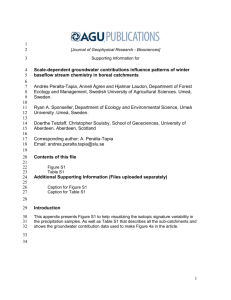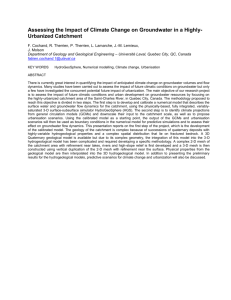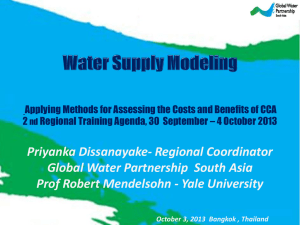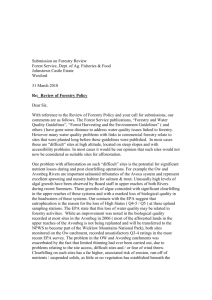Forest, Land and Water Policy: Improving Outcomes
advertisement
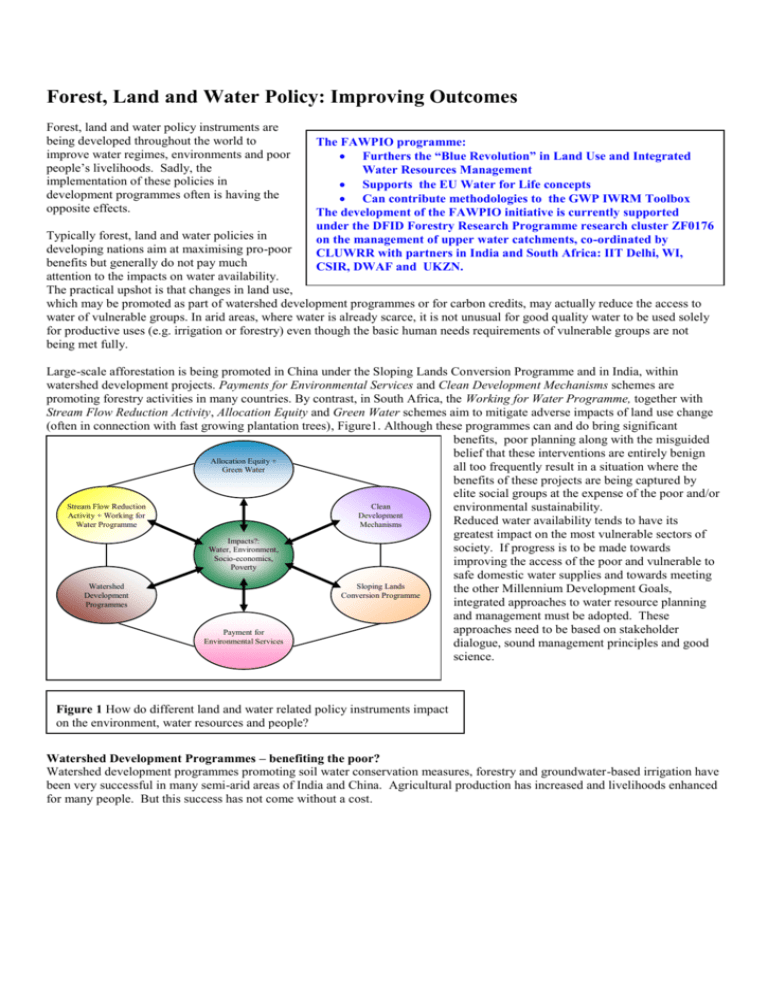
Forest, Land and Water Policy: Improving Outcomes Forest, land and water policy instruments are being developed throughout the world to improve water regimes, environments and poor people’s livelihoods. Sadly, the implementation of these policies in development programmes often is having the opposite effects. The FAWPIO programme: Furthers the “Blue Revolution” in Land Use and Integrated Water Resources Management Supports the EU Water for Life concepts Can contribute methodologies to the GWP IWRM Toolbox The development of the FAWPIO initiative is currently supported under the DFID Forestry Research Programme research cluster ZF0176 on the management of upper water catchments, co-ordinated by CLUWRR with partners in India and South Africa: IIT Delhi, WI, CSIR, DWAF and UKZN. Typically forest, land and water policies in developing nations aim at maximising pro-poor benefits but generally do not pay much attention to the impacts on water availability. The practical upshot is that changes in land use, which may be promoted as part of watershed development programmes or for carbon credits, may actually reduce the access to water of vulnerable groups. In arid areas, where water is already scarce, it is not unusual for good quality water to be used solely for productive uses (e.g. irrigation or forestry) even though the basic human needs requirements of vulnerable groups are not being met fully. Large-scale afforestation is being promoted in China under the Sloping Lands Conversion Programme and in India, within watershed development projects. Payments for Environmental Services and Clean Development Mechanisms schemes are promoting forestry activities in many countries. By contrast, in South Africa, the Working for Water Programme, together with Stream Flow Reduction Activity, Allocation Equity and Green Water schemes aim to mitigate adverse impacts of land use change (often in connection with fast growing plantation trees), Figure1. Although these programmes can and do bring significant benefits, poor planning along with the misguided belief that these interventions are entirely benign Allocation Equity + all too frequently result in a situation where the Green Water benefits of these projects are being captured by elite social groups at the expense of the poor and/or Stream Flow Reduction Clean environmental sustainability. Activity + Working for Development Reduced water availability tends to have its Water Programme Mechanisms greatest impact on the most vulnerable sectors of Impacts?: society. If progress is to be made towards Water, Environment, Socio-economics, improving the access of the poor and vulnerable to Poverty safe domestic water supplies and towards meeting Watershed Sloping Lands the other Millennium Development Goals, Development Conversion Programme integrated approaches to water resource planning Programmes and management must be adopted. These approaches need to be based on stakeholder Payment for Environmental Services dialogue, sound management principles and good science. Figure 1 How do different land and water related policy instruments impact on the environment, water resources and people? Watershed Development Programmes – benefiting the poor? Watershed development programmes promoting soil water conservation measures, forestry and groundwater-based irrigation have been very successful in many semi-arid areas of India and China. Agricultural production has increased and livelihoods enhanced for many people. But this success has not come without a cost. BEFORE Rain Fed Agriculture Small scale irrigated agriculture Flow Out of Catchment Hand pump provides free drinking water supply ‘Public’ water in village Tank Run Off AFTER KEY Increased evaporation as compared with ‘before’ scenario Soil Water Conservation Structures - which intercept flows into ‘public’ tanks Increased recharge for ‘private’ groundwater Groundwater Irrigation using “private” water– Reduced covering larger ‘public’ area water in Village Tank Water Table Community has to rely on tankered water during drought Minimal Flow Out of Catchment Hand pump failure through lowered water table Water Table Electric submersible pump Figure 2 Impact of catchment interventions on water flows and availability of “private” and “public” water. Projects based on water-related “myths” and implemented without due regard to water resource constraints often fail to meet environmental sustainability criteria or to deliver the expected benefits to the very poorest communities. Reduced water availability may even rob them of basic water and sanitation needs. To make things worse, less vulnerable people may not have the resources to continue exploiting diminishing water supplies, further contributing to the inequitable use of resources. Some projects may also contribute to inter-sectoral, water and energy resource conflicts. In some southern Indian States, as much as two-thirds of all the electricity generated is used to pump groundwater for irrigation. The promotion of forestry, irrigation and soil water conservation measures, particularly in catchments which are approaching closure1 has often had the perverse and inequitable effect of reducing the availability of “public” water in communal village tanks yet increasing the “private” water available to farmers with access to deep groundwater resources, Figure 2. The promotion of irrigation that involves mining groundwater and the substantial lowering of water tables is unsustainable in the long term, leads to “boom” and “bust” cycles in agricultural production, and incurs huge costs in terms of electric power generation for pumping groundwater from greater A “sanctioned discourse” is developing within some depths. government and donor circles leading to watershed activities, such as forestry and watershed development, being promoted as benign technologies that are, at the very least, “poverty neutral”. There is now a self-reinforcing tendency within government and donor agencies to disregard information and arguments that contradict the received wisdom as to the best solutions to water-related problems for the poor. This attitude remains even when circumstances change radically, as happens when a region moves from water surplus into water deficit. In 1 deficit conditions there is overwhelming evidence to show that Closure (using IWMI terminology) occurs in a many present water-related policies and practices are doing catchment when supply equates to demand (i.e. when all available water resources are fully allocated). little to benefit the poor – and little to achieve the relevant Millennium Development Goals. Initially, this will only occur in “dry” years but if demand continues to outstrip supply, closure will also occur in average and “wet” years. Water-related myths Water harvesting is a totally benign technology Planting trees increases local rainfall and runoff Runoff in semi-arid areas is 30–40% of annual rainfall Rainfall has decreased in recent years Aquifers once depleted stay depleted Watershed development programmes drought-proof villages and protect village water supplies Introduction of drip and sprinkler irrigation frees up water for other uses Green Water and Allocation Equity –an improved framework for land and water management? South Africa is at the forefront of research into the hydrological impacts of land use change and the development of innovative land and water management policies. Many of these policies are focused on catchment runoff (sometimes termed Blue Water) and on maintaining a portion of this for ecological “use” (the ecological reserve). Recognising that land use can alter stream flow, certain land uses (only commercial forestry at present) are now defined as “Stream Flow Reduction Activities” (SFRAs) with the aim of charging owners of SFRA land for the water they consume. “Green Water” policy instruments (using Falkenmark, 2003, Green Water and Blue Water terminology) are seen as an alternative approach. They focus more on the portion of rainfall – in arid and semi-arid conditions usually the greater portion– which leaves the catchment in vapour form as evaporation (Green Water). For South African catchments, typically only 10–30% of the rainfall generates runoff in the rivers. Green Water policy instruments recognise that different land uses evaporate more or less water as green water, and that this could be managed through SFRA type instruments by charging for high waterutilising land uses and possibly by payments for low water-utilising land uses such as dryland agriculture. LOW WATER FOR LARGE SCALE PRODUCTIVE USERS PUBLIC INTEREST WATER REQUIRED TO SUSTAIN LIVELIHOODS WATER REQUIRED FOR BASIC HUMAN NEEDS HIGH LOW HIGH IMPACT Figure 3 Proposed approach to balancing water resource impacts and public interest being tested in South Africa. Allocation Equity is a mechanism being developed in the South African Department of Water Affairs and Forestry (DWAF) for the equitable allocation of catchment runoff amongst all users – including the poorest – while ensuring that the water use is both in the “public interest” and that changes in allocation are negotiated in a sensitive and transparent manner between users, Figure 3. Impacts on “investor confidence” and commercial returns are thus minimised. DWAF (2004) recognises that sustainable development “should reflect a balance between social justice, economic efficiency and ecological integrity”. Inherently, this approach recognises that achieving more equitable allocation and use of water promotes social stability and is therefore, in itself, in the public interest. Plus, the process promotes shifts towards more beneficial water uses that realise greater economic returns and employment opportunities. Programme Outputs Drawing on the ideas underlying Green Water and Allocation Equity Policy instruments, the programme will develop and promote guidelines, worldwide, for land and water management policies to ensure more equitable, environmentally sustainable and beneficial water allocations through two interlinking components. Figure 4 FAWPIO “Bridging Research and Policy” network 1. BRAP (Bridging Research And Policy) Networks. BRAP procedures, incorporating advocacy and promotion techniques, will connect and disseminate new knowledge of the biophysical and socio-economic outcomes of land and water interventions to policy makers through peer-to-peer networking of policymakers and through interactive workshops and innovative media including e-fora and electronic journals, e.g. Land Use and Water Resources Research ( http://www.luwrr.com hosted by Venus Internet), Figure 4. Water resource Build commitment 2. An improved framework for assessments to reform land and water management. The improved framework, incorporating the GWP IWRM Cycle Monitor & (Figure 5), will specifically include: evaluate progress i. Hydrological assessment of all water uses and users within a Integrated water resources Analyse gaps catchment. management cycle ii. Catchment Stress Implement Assessment to determine to what frameworks extent the catchment is approaching “closure”, or not meeting aquatic ecosystem requirements. Build commitment Prepare strategy iii. Strategic Environmental to actions & action plan Assessment to identify, using Social Account Matrix approaches, the economic returns and employment Figure 5 FAWPIO methodologies will incorporate the GWP Integrated Water opportunities that arise or potentially Resources Management Cycle could arise from water use in the catchment. iv. Negotiation support, through use of a negotiation support “toolkit” , will provide to catchment water users: Methodologies for contextual analysis (forest and water narratives, beliefs underlying policy), Web and GIS based dissemination tools, Blue and Green water integrating methodologies encompassing the social accounting matrix, An “Allocation Equity Guide”, providing guidelines to support stakeholder negotiations, Environment impact assessment methodologies, primarily in relation to biodiversity and water quality, Poverty reduction impact assessment methodologies, addressing the questions: who are the winners and losers of these policies? Will the outcomes of the policy instruments benefit key poor and vulnerable groups? v. Monitoring and evaluation. The impact assessment methodologies outlined above will also provide the basis for monitoring and evaluating the socio-economic, poverty and water resource outcomes of catchment interventions. Partners and Funding The FRP FLOWS cluster of projects (R8171, R8174, R7991, R7937, ZF0176), upon which much of the FAWPIO programme has been based, is supported under the United Kingdom Department for International Development (DFID) Forestry Research Programme. The FAWPIO programme is seeking further linkage with donors, UN organisations, the Global Water Partnership, NGOs and partner countries and institutions to establish this programme. The views expressed here are not necessarily those of the DFID ZF0176 Forestry Research Programme


